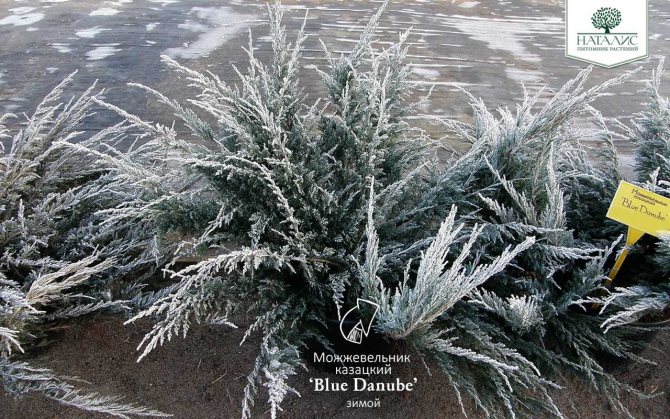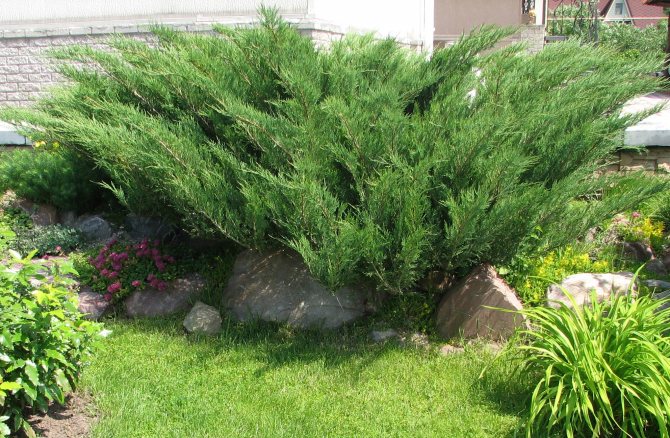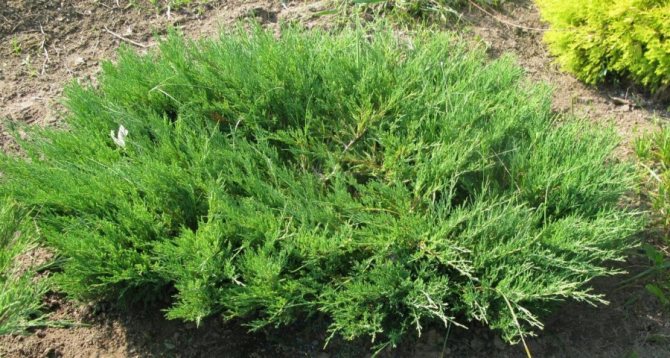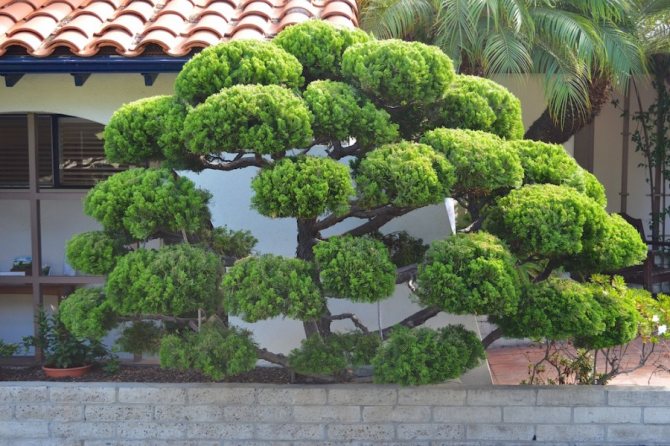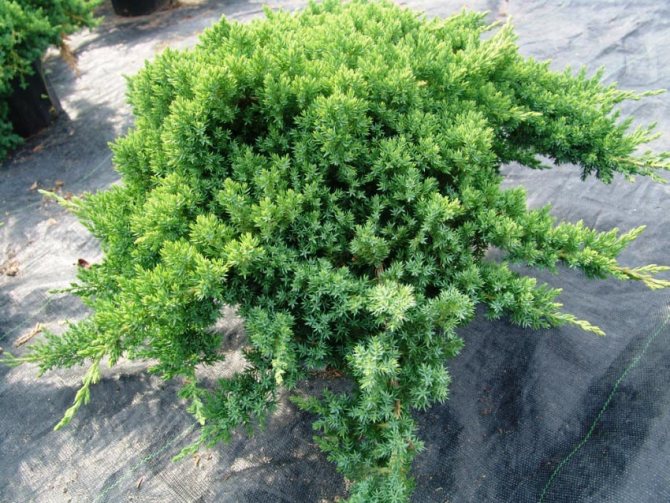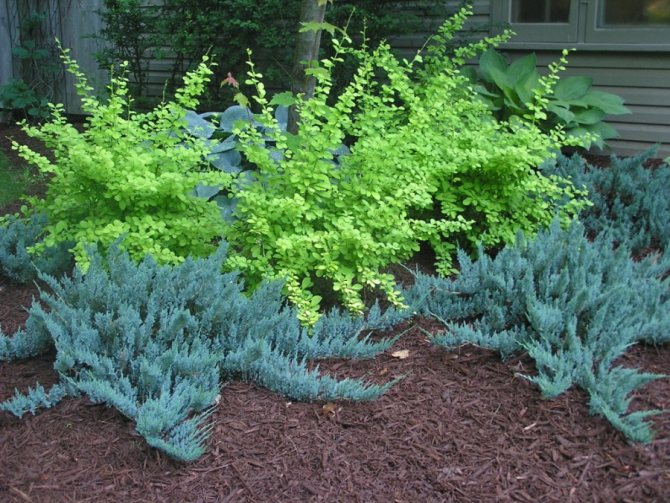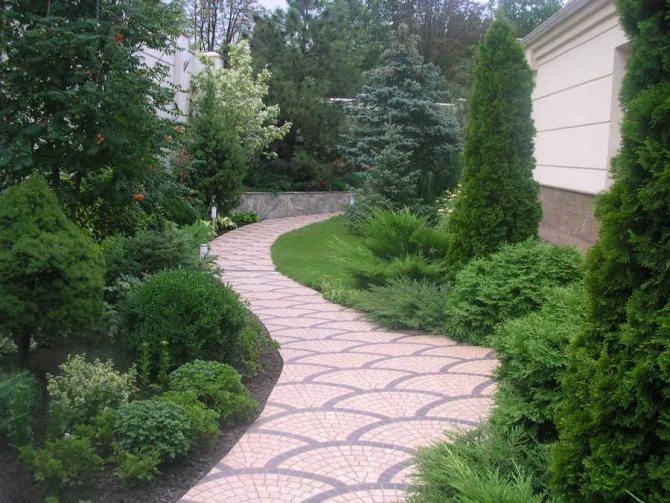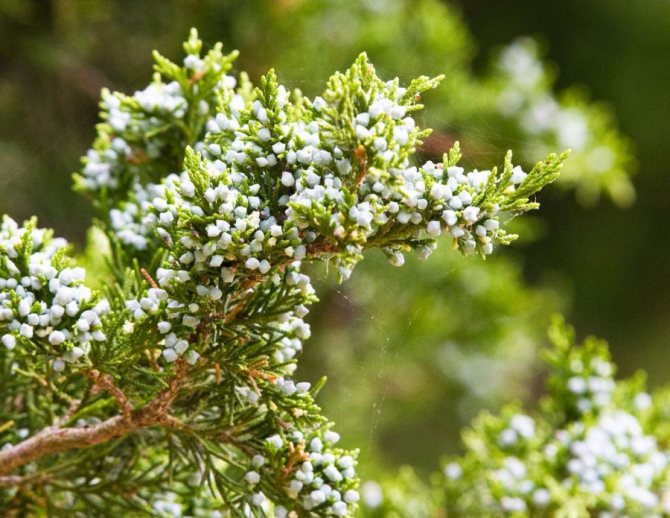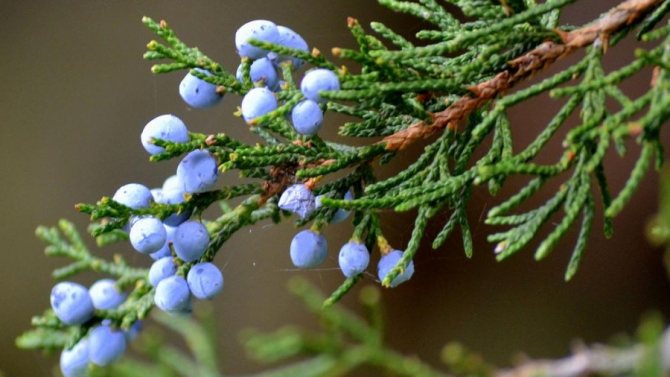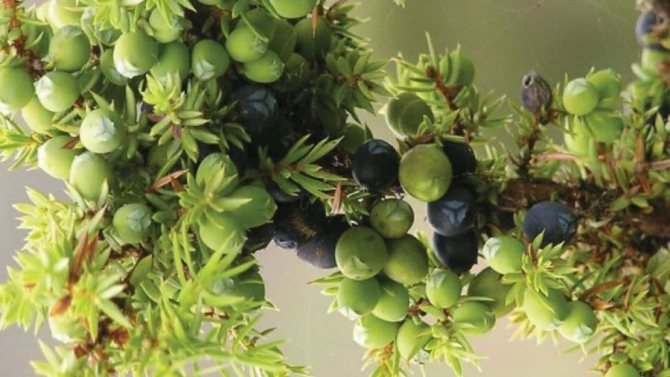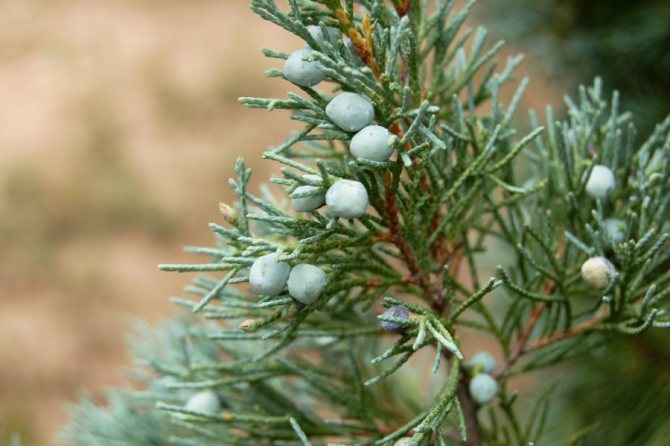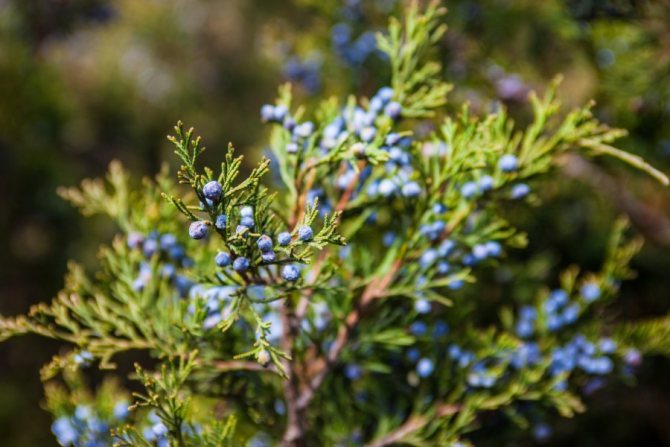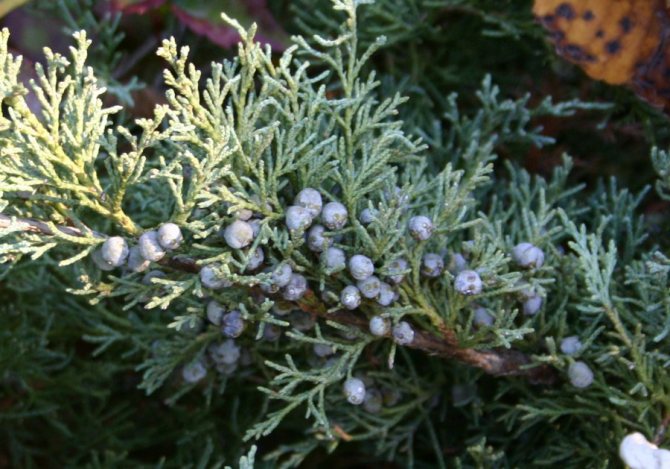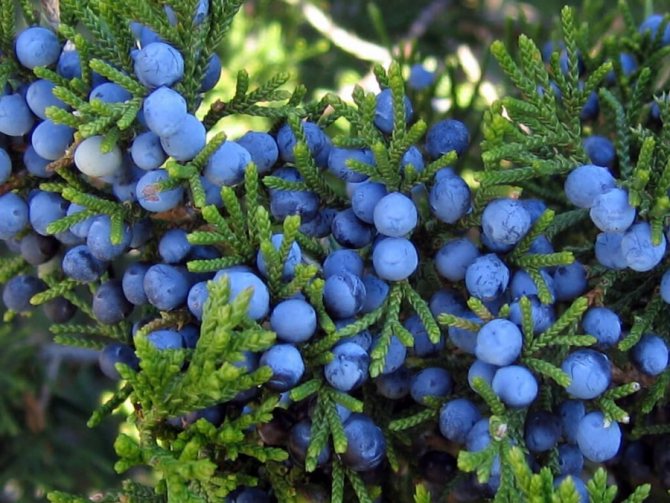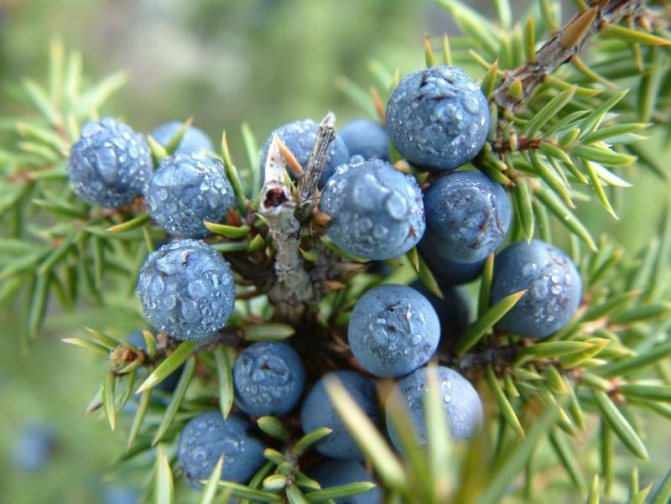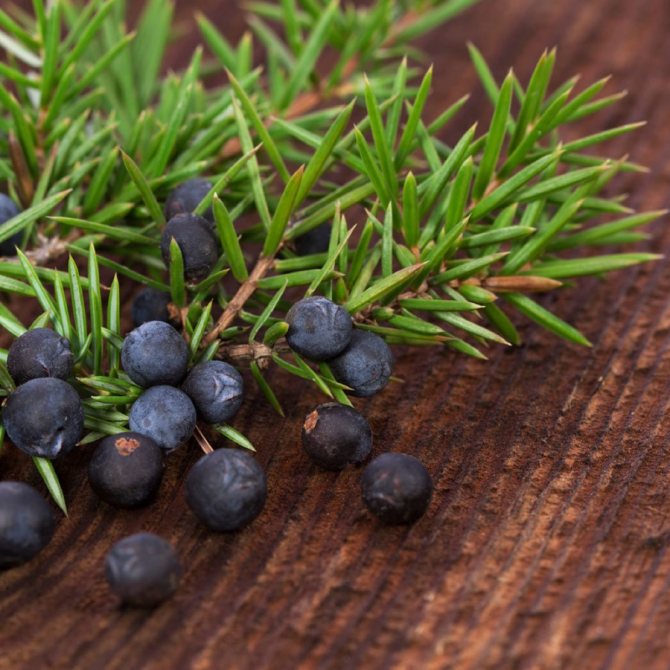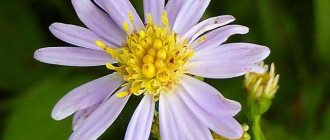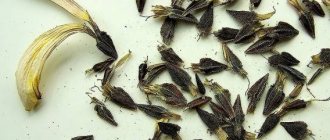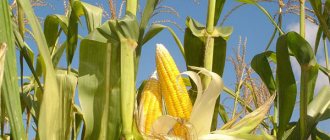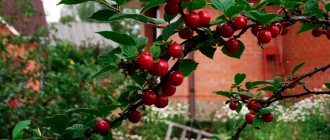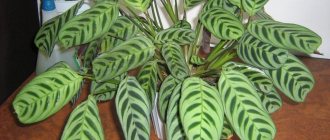Somehow, quite separately, among other evergreens in the garden, the juniper is valued, whose very presence heals many diseases. The plant, friendly to people, is one of the favorite crops that fills the air with life-giving resins and amazes with a beauty that is dear to the heart, perfectly combined with many green friends. Juniper is a rather unpretentious coniferous plant. But in order to properly plant it and take care of it, you need to know a few basic rules.
When to plant junipers in autumn
Not everyone knows that autumn is a good time of the year for planting junipers. If the seedling has a powerful rhizome, then when planted before November, it has every chance to take root and safely adapt to the low temperatures of winter. Caring for junipers in the fall and preparing for winter is an event that requires a serious approach.
Important! The end of winter is not a reason to relax. A coniferous tree can also die in the spring, when the rooting process is completed: at this time, recurrent frosts occur. The cause of the trouble may be a weak, diseased root or a violation of an earthen coma. It is worth noting that small specimens are recommended to be started in the spring. Thus, before the winter frosts, they will be able to take root and withstand bad weather.
Why exactly juniper
In general, coniferous crops began to be used for landscaping the site for a long time, because they delight with their beauty at any time of the year. In the past few years, designers have also adapted juniper to decorate territories, since its unique appearance can significantly change the decorated area. Its sizes, combining both dwarf species and specimens reaching the size of full-fledged trees, are able to combine a large number of decorating styles available to lovers of evergreen perennials.
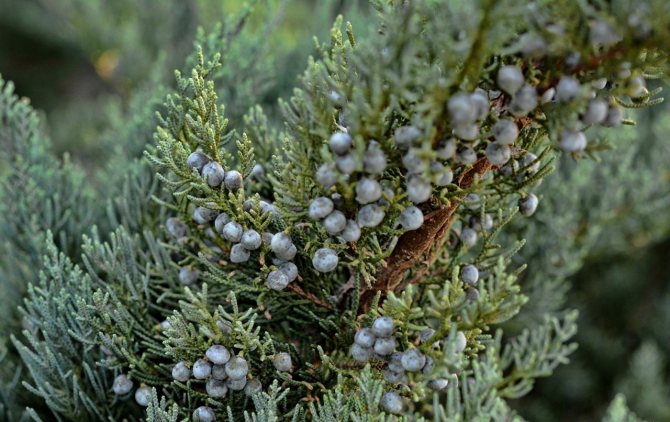
Juniper
How to plant junipers in the fall
Before planting a juniper seedling in a new place, in the fall, a year before transplanting, the plant is deeply dug in: the diameter should not be less than the diameter of the crown. Then the rhizome is trimmed and the juniper seedling is given time to recover.
It is also necessary to know that mature plants are also unsuitable for transferring to a new place. Even under ideal conditions, a mature specimen will not tolerate stress. If, nevertheless, transplanting an adult plant is inevitable, it is worth trying to plant a juniper in winter, when the root ball is sufficiently frozen. When performing such a procedure in February, you can count on the probability of the survival of the seedling.
Landing site preparation
Soil structure does not play a decisive role. In the matter of land, juniper is undemanding, but when choosing a place, light and loose soil should be preferred. An exception may be clay soil - the seedling will not take root on it. Only the Virginia juniper bush can assess the properties of clay.
If you scrupulously adhere to the rules, then the Central Asian and Cossack varieties take root best in alkaline soil. Siberian - loves sandy loam and sandy soil. For the rest, acidic soil is more acceptable.
In the spring or in the middle of autumn, a new place is selected for the plant.Juniper takes root perfectly in sunny areas. In this case, it is important that the light of the sun comes in during the day. If the seedling is placed in the shade, it will not be possible to form a beautiful shape from scanty branches. Moreover, the color of the plant will become pale, uninteresting. The dimensions of the deepening for planting are twice the size of an earthen lump, they introduce a drainage layer consisting of broken brick, pebbles and sand. The thickness of the layer varies from 15 to 25 cm.
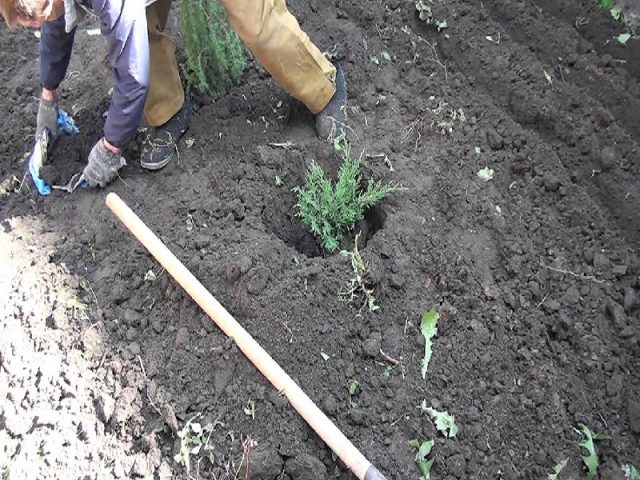

Seedling preparation
Before submerging the seedling in the ground, it should be treated with a growth stimulant. When planting in dry soil, the bush is pre-saturated in a container with water, protected from direct sunlight.
The pit is filled with water, the soil is thoroughly moistened. To prevent the attack of insects, the juniper seedling is watered with special chemicals after planting. This action must be carried out repeatedly until the plant "gets sick" in a new place.
A step-by-step guide on how to plant a juniper in the fall
If you adhere to the recommendations of experienced gardeners and follow a step-by-step algorithm of actions when preparing a juniper for winter, the growing process will not create difficulties. Correct organization of actions:
- In the prepared soil, the landing sites are outlined. The interval between seedlings is maintained at 1.5 - 2 m.For varieties of dwarf species that do not tend to grow, the distance is reduced to 0.5 - 1 m.
- Pits are prepared, focusing on the root system. They should be twice the size of an earthen coma. The approximate dimensions of the hole for a three-year-old seedling are 50x50 cm.
- A drainage layer of broken brick and sand (15 - 20 cm) is brought to the bottom of the pit. A mixture of soil, turf, sand, peat is also poured in.
- Before the autumn planting of juniper for the winter, it is recommended to add up to 300 g of a nutrient - nitroammophoska to the hole. The drug is classified as universal, it is suitable for all types of garden plants.
- The pit is allowed to stand for 21 days. Thus, the soil will settle, and when planting a juniper seedling, the rhizome will not additionally suffer.
- A seedling is immersed in the hole, covered with earth, fertilizers are not applied.
Why does the plant die
Sometimes it happens that the seedlings planted in the fall tolerate the winter well, but die in the spring. What is the reason for this?
- Problems can arise if you are replanting a plant that is already an adult. In this case, trauma to the root system inevitably occurs. Considering that juniper roots take a long and hard time to recover, the plant often dies. The most capricious variety is considered to be "Ordinary", it is important for him to provide appropriate growing conditions and take proper care after planting. Creeping varieties are less whimsical in nature, however, they also need shelter from the bright sun.
- In winter, air humidity increases. Due to the fact that the stomata of the tree are closed, moisture is retained and the tree remains green. In early spring, when it gets warm, the stomata open, the water evaporates, the tree needs moisture, but the roots are not able to get water from the ground, as it is frozen. Thus, the tree dries up. To avoid such troubles, it is necessary to purchase seedlings grown in containers. If you are replanting a self-grown seedling, you should keep an earthen ball.
Important: experts do not advise replanting plants from the forest to a personal plot.
- Another reason for the death of a handsome coniferous man is cold. Heat-loving varieties should be properly covered for the winter period. The soil is mulched and the crown is tied.
Regardless of the chosen planting time and variety, juniper, as a rule, quickly and well takes root in a new place. Even an inexperienced gardener will have no problem growing a coniferous tree.
Juniper care in autumn
There are no special requirements for the care of junipers in the fall.It is distinguished by good endurance, survives low winter temperatures and drought in the heat, but on condition that the root system has completely taken root. A transplanted plant needs watering, since a weakened root cannot always go deep into the bowels of the earth to recharge. Irrigation of the seedling will be useful.
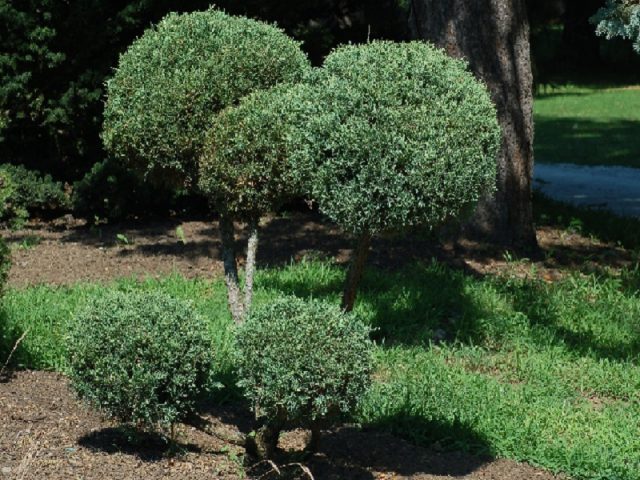

How to water a juniper in the fall
Only a year after a successful planting, the juniper can not be watered in autumn and even summer. If the heat is aggressive and drying out the soil, the plant is watered abundantly, but not more often than once every 14 days.
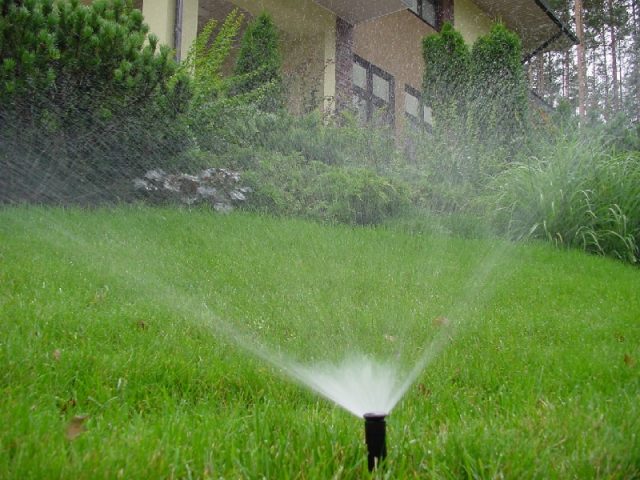

How to properly prune junipers in the fall
Pruning of common juniper in the fall is carried out if the plant is grown for the purpose of decorating the site. Figuratively form or simply remove excess processes. It is also necessary to eliminate dry, broken, limp branches. The rules for cutting seedlings are universal for all conifers. The plant must be well-established, with no signs of disease. For some varieties, it is impossible to form a crown.
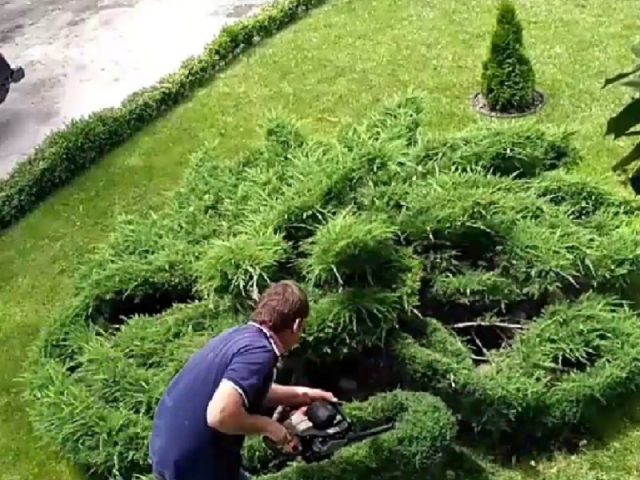

Juniper pruning in the fall is not always carried out according to the scheme. The choice of shape should be appropriate for the landscape. Sometimes gardeners leave a natural crown.
How to feed
When planting a juniper in the fall before winter, the plant should be saturated with fertilizers. Thus, before the cold weather, the support of the easily injured root system of the seedling is carried out.
For fertilization, humus that has stood in the pile for at least 1.5 years is used.
If humus was introduced into the soil during planting, the manipulation is not repeated for the next three years. The fact that there is an excess of nitrogen in the earth will be indicated by the yellow color of the needles, dry branches.
To make compost, the top layer of soil above the roots is dug up, watered and mulched.
What varieties can be used for planting outdoors
For decorating rocky areas, the Cossack juniper, which is dwarf, is perfect. This type is the most common and fastest growing, therefore it has gained great popularity among gardeners and professionals. Juniper Cossack Variegata in landscape design differs from other varieties in that it stretches along the ground, but at the same time its spreading crown has a stunning blue-green color and has a pungent coniferous smell.
Thuja in landscape design
Another good variety of creeping shrubs is horizontal juniper, the needles of which have a deep gray-green color with a slight bluish haze. The plant reaches 0.5 m in height and is perfect for decorating the edges of borders. Also, for these purposes, a cup-shaped Siberian juniper with gray prickly needles may be suitable.
Note! One of the tall varieties that goes well with any culture is the Chinese juniper, reaching up to 10 m in height. The range of shades ranges from different tones of green to golden yellow.
Juniperus virginiana is also suitable, which, as a rule, is represented by tall columnar species.
An interesting option for planting can be the ordinary Hortsmann juniper, the crown of which, as it grows, looks as if drooping, forming a unique plant shape.
Another type of common juniper, which is distinguished by a chaotic pyramidal shape, is Suecik. This species reaches up to 10 m in height.
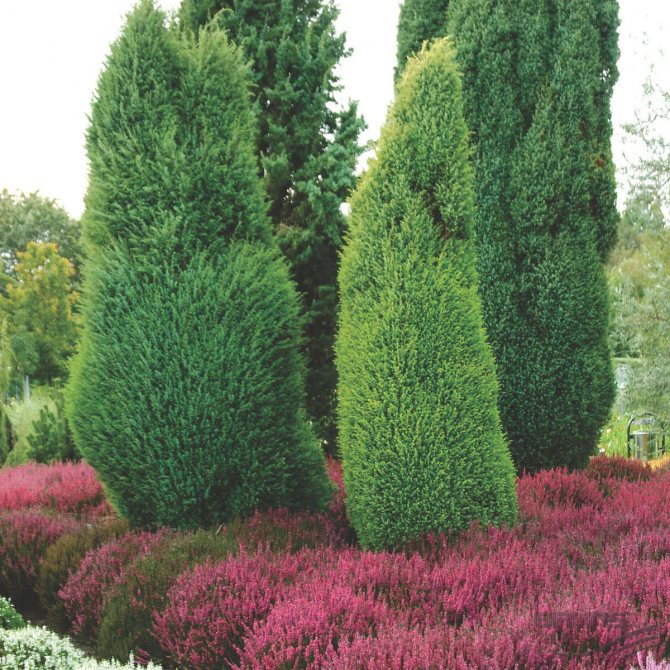

Suecika
How to care for junipers in winter
Juniper is resistant to low temperatures, so in winter there is not much work on caring for the tree - all the main preparatory measures are carried out in the fall, before winter arrives. To prevent snow drifts from breaking the crown, the bushes are tied up. It is especially characteristic of juniper plants that have undergone formation to "crumble".
Is it possible to prune junipers in winter
The best time to form a bush is considered to be spring and summer. If we are talking about the middle lane, then the second half of summer for haircuts is already undesirable. Juniper may not have time to "get sick" before the onset of the cold winter.
Juniper pruning in the fall is carried out for sanitary purposes, to remove dry and damaged branches, without touching the living. Before starting the procedure, you should make sure that the plant is healthy. If in doubt, the formation of the bush should be postponed until spring.
In winter, you can also use sharp garden shears, but only cut dry branches, without affecting the living fragments.
How to water a juniper in winter
In winter, the juniper is watered only if it grows at home, on the windowsill. Watering frequency does not exceed twice a month. The coniferous culture loves to be irrigated every other day. In this way, dense, lush greens are obtained.
Do I need to cover the juniper for the winter
The bush can withstand low temperatures, but if the juniper has not reached three years, it must be sheltered for the winter in the fall. Some varieties tend to react negatively to temperature changes in spring. The fact that the juniper is not comfortable when changing from minus to plus and vice versa will be indicated by the faded shade of the plant and the yellowish-brown color of the branches.
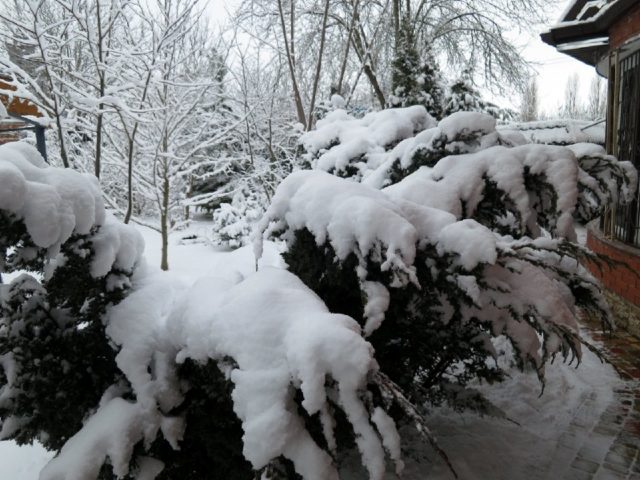

How to cover a juniper for the winter
Juniper shelter for the winter is carried out at the end of autumn using any of the proposed methods:
- In regions with snowy winters, the easiest way to cover the root system is to use snow. After the first snowfall, the previously tied bush is insulated with a snowdrift. For these purposes, only freshly fallen precipitation is suitable. The procedure requires care, as it is important not to damage the branches and trunk.
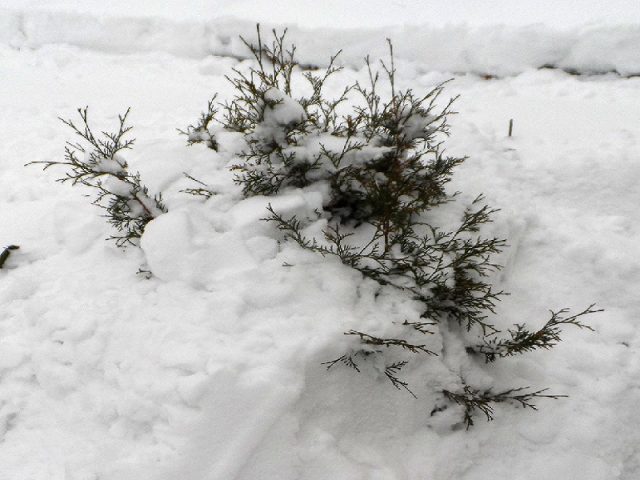

- Young non-bulky shrubs are superbly insulated with pine spruce branches. Large ones are tied with needles, small ones are covered on top.
- In regions where snow falls unstably, agrofibre or burlap is most often used to shelter juniper plants. The crown is wrapped in such a way that the bottom of the tree is open. How to properly organize the process of saving a juniper in winter is well shown in the photo of sites and forums of gardeners on the Internet.


- An interesting and effective way to insulate a juniper is to install a reflective screen. Having placed it on the side of the sunlight, they ensure that the rays grill the crown.
If the seedling is not permanently planted, it can be brought into greenhouse conditions for the winter in late autumn. Thus, additional care is easily avoided. Particular attention should be paid to preparing junipers for winter in regions where temperatures drop to -30 o C.
Juniper in garden design
Astilba in landscape design
A summer cottage can be easily decorated using both creeping and upright varieties.
Flowerbed with juniper
Note! Conifers are used in almost any style of landscape design. The main thing is to take into account their compatibility with other plants, and also that junipers should grow at a distance of 1 to 4 m from each other, depending on the specific species.
When decorating a flower bed, many wonder what to plant next to a juniper? There are many options. Growing hydrangea and juniper will perfectly complement each other. But juniper and pear are a very dangerous neighborhood, as a fruit tree can easily wither away. Ephedra is a good breeding ground for the rust fungus that infects many crops. It is best to plant other plants with it, for example, tulips, roses, daffodils, other conifers, dogwood, honeysuckle, etc.
In addition, the juniper will look good on the alpine slides. For an English-style garden, you can choose pyramidal and columnar varieties.If you have the proper skill, the edges of the paths can be decorated with junipers on a trunk, or you can place such a beautiful shrub in the center of any compositions. A flowerbed with hosts and junipers would also be a good option.
Important! Dwarf species should be planted next to tall plants, and vice versa, so that they do not block the sun for each other.
Hedge juniper
Compositions with juniper bushes are not limited to flower beds. You can also create hedges with your own hands, which will become an amazing variation of the fence. Such a creation looks good in combination with trees, for example, birch, and also beautifully encloses the territory of the flower beds. Such a fence can also be created against a red brick background.
For its formation, it is worth paying attention to the high-growing varieties of ordinary, Virginia and Chinese junipers. But it is worth remembering that the last variety will have to be covered for the winter.
Important! To give the desired shape to the bush, you need to acquire garden shears and hedge trimmers. The sides are trimmed in May and September, but the top can only be trimmed after reaching the age of 10.
Winter hazards
Juniper is a frost-resistant crop. It tolerates cold and frost normally, but under the influence of strong wind and scorching sun rays, it loses not only its decorative appearance, but can also die. The drying winter wind contributes to the rapid loss of life-giving liquid, as a result of which the branches become brittle, freeze and break off. That is why in the spring you can often find shrubs with broken off dry shoots and yellow-brown needles. Sunburn during sudden long thaws contributes to the opening of the stomata of the needles - the plant begins to breathe actively, the process of moisture evaporation is activated.
Reproduction of juniper by seeds
Reproduction of juniper by seeds is used extremely rarely, from seeds you can grow not a decorative, but a wild tree. For this method, you must use freshly harvested seeds. If you take those that are more than 1 year old, then their germination will be significantly reduced.
Sowing work begins in late autumn. The seeds are sown in large boxes with prepared soil, which are then exposed outside under the snow. This process is called stratification - keeping seeds at a certain temperature in order to achieve faster germination.
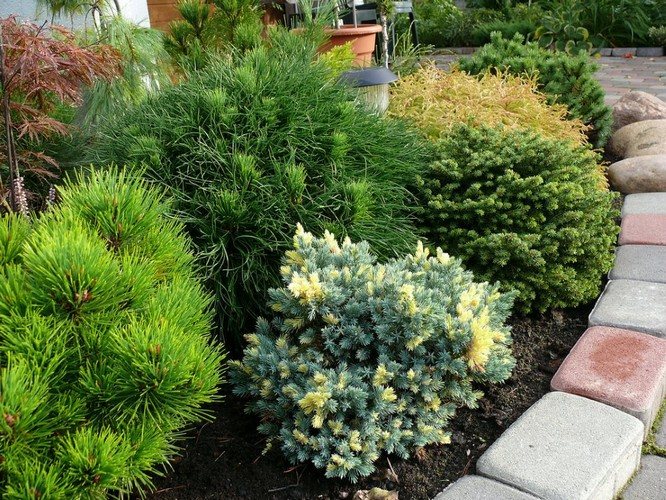

You can also sow seeds during early spring, but here it is necessary to adhere to a temperature regime that does not exceed 25 ° C. To speed up germination, seed scarification can be applied. This method consists in damaging (scratching) the hard shell of the seed, which as a result allows you to get earlier shoots.
Autumn work front
The active preparation of the shrub for winter begins in the fall. Before the shelter of the juniper, the necessary agrotechnical measures are carried out: water-charging irrigation, pruning, treatment from pests and diseases.
Watering and spraying
The need for watering depends on the weather: if the fall is rainy, then the plant does not need additional moisture. Otherwise, if the hot summer has turned into a mild dry autumn, it is necessary to water the juniper once every 2 weeks. For a medium-sized bush, you will need about two ten-liter buckets of water. Immediately before the shelter, 4–5 buckets of water are poured into the near-trunk zone, which is better to loosen a little.
A layer of mulch will help trap moisture and provide ventilation. Spraying has a beneficial effect on the appearance and health of the plant. To do this, use settled water at room temperature.So that the shrub does not suffer from the sun's rays, which, together with moisture, can burn out the needles, the procedure is recommended to be carried out early in the morning or after sunset.
Pruning


Autumn pruning takes place in mid-November. During it, dry and damaged branches are removed. If necessary, the formation of the crown of the bush takes place in the process. However, when pruning, you should be careful: the shoots grow back slowly. It is impossible to remove too much of the shrub at a time, it will not have time to recover before winter.
Protective measures
The most ardent enemies of juniper are rust and aphids. Dust and spider mites can be just as dangerous. Treatment of the shrub with the drug "Abiga-Peak" will help prevent the development of the disease and cure the plant. For a full result, you will need 4 spraying at intervals of 10 days. Insecticidal preparations "Fitoverm" and "Fufanon" perfectly cope with pests.
Types (types) and varieties of juniper
Among junipers, their following shapes and sizes can be distinguished:
- Tree-like;
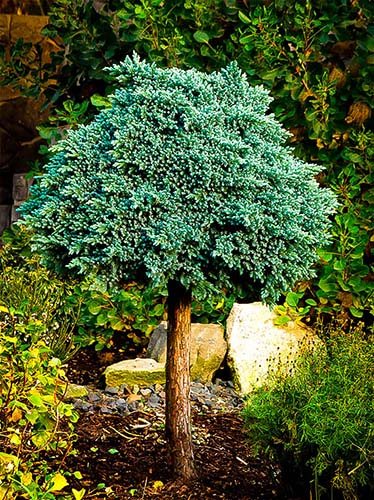

- Columnar;
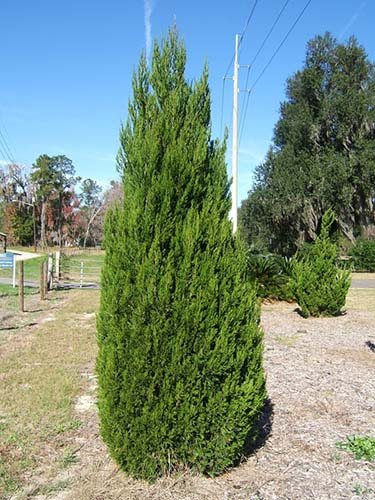

Virgin spartan - Shrub (with spreading bushes);
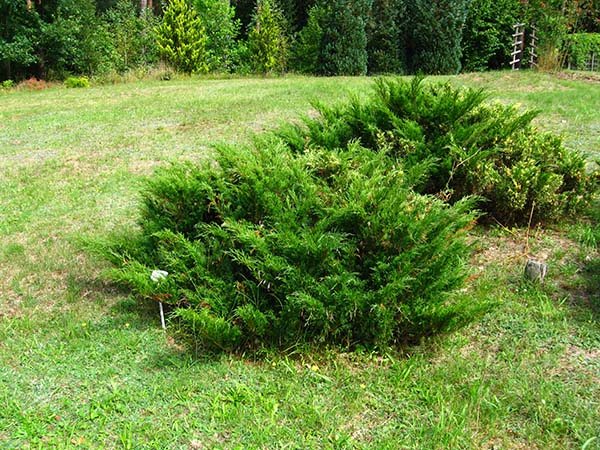

Cossack Sabina - Low-growing (creeping, ground cover).
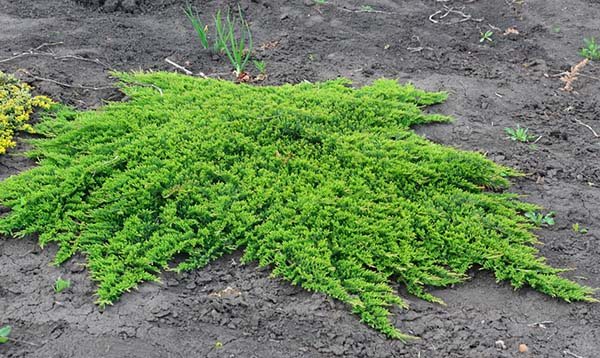

Horizontal Prince of Wales
The most popular types and varieties of juniper are:
- Ordinary (Depressa Aurea, Meyer, Green Carpet, Horstman, Repanda, Arnold);
- Virginian or North American (Gray Oul, Skyrocket, Hetz, Glauka);
- Cossack (Variegata,
Blue & Gold
,
Tamariscifolia, Rockery Jam, Glauka, Sabina); - Horizontal or outstretched (Lime Glow, Wiltoni, Blue Chip, Prince of Wales);
- Chinese (Strickta, Kurivao Gold, Spartan, Variegata);
- Rocky (Blue Arrow, Blue Haven, Munglow);
- Scaly (Dream Joy, Blue Star, Blue Carpet).
In more detail you can get acquainted with the appearance of different junipers in the following videos or in the last paragraph "What is better to plant - a juniper or a thuja?"
Video: types and varieties of junipers
Shelter by the rules
After carrying out the necessary agrotechnical measures in the last decade of November, the juniper is covered. The near-trunk zone is mulched with peat, the branches are tied around the trunk. The harness will help prevent damage to branches and freezing of the trunk. You can cover the juniper with:
- Snow. A snowdrift of loose snow falls on the connected structure. It is important to ensure that the snow does not freeze and damage parts of the plant during the shelter process.
- Lapnik. Pine needles are perfectly permeable to air and moisture and at the same time protects the plant from wind, snow and sunlight.
- Burlap or non-woven fabric (agrofibre, spunbond). Part of the bush is wrapped in a special material, leaving the bottom uncovered. The film will not work for this purpose - the plant can resist under it.
- Screen. It is usually installed on the sunny side to accumulate energy from the sun and warm the plant.
In regions with harsh winters, young animals are often dug up, placed in a container and brought into a cool room. Mature plants are insulated with a special covering material, wrapped several times, and covered with additional snow on top.
Typical mistakes
Ordinary summer residents and inexperienced gardeners often make mistakes that can become irreparable:
- Waterlogging. Abundant watering contributes to waterlogging of the soil and the development of the decay process. Root decay negatively affects the health of the entire plant.
- Improper feeding. Untimely or excessive fertilization of juniper with nitrogen-containing dressings promotes active growth of shoots, which prevents the plant's root system from accumulating the necessary nutrients for wintering.
- Improper pruning and processing of cuts with garden pitch. Excessive pruning can cause a tree to stop growing and developing. Garden varnish processing "preserves" the cut site and interferes with the emergence of young shoots.
- Use as a top dressing chicken manure or mullein.
Common juniper dressing
Common juniper is quite unpretentious in care. However, fertilization has a good effect on the condition of the shrub. It is better to feed the shrub in the spring, when young shoots are growing. As a top dressing, nitroammofoska is used, which is laid out under each bush and shallowly embedded in the root zone. In the fall, fertilization is finished, otherwise the young shoots will not be able to withstand the winter frosts.
Fresh articles about garden and vegetable garden
Gerberas in pots: home care
Growing lavender outdoors
Regional distinctive features
The need for shelter and the method depend on the climatic conditions for the growth of the plant. Juniper care in autumn and summer in different regions also has its own characteristics. In the areas of the Volga region, juniper must be protected primarily from sunburn. For this, the plant is loosely wrapped several times with cotton cloth, burlap, tulle so that the shrub breathes. In the middle lane, the plant is most often covered with spruce branches and snow is poured on top. In Siberia and the Urals, they are wrapped with a special covering material, young trees are dug up and brought into the room.
Correct application of fertilizer
In our area, junipers are resistant to many diseases and do not need special feeding and spraying. It will be enough to water in dry seasons and "feed" with nitrogen and complex fertilizers several times during the season.
Fertilizing conifers with animal humus is strictly prohibited.
From such "fertilization" the roots of the juniper burn and the plant dies. The nutrition of the trunk will deteriorate and the plant will begin to dry out if the soil around the plant is loosened. For a juniper, it is enough to mulch (cover) the soil with coniferous soil, which was previously collected in a pine forest.
You can preserve the brightness and saturation of the color of the plant by regular watering (not pouring), feeding with micronutrient fertilizers in early spring and late summer.
Features of caring for juniper in the fall and in preparation for winter - general tips and tricks
Juniper does not have a capricious disposition. But if you do not follow certain rules, then a beautiful plant can wither, it will cease to have a decorative appearance, it will turn into a wild tree.
It is recommended to perform the following activities for the care of juniper in the autumn period of time:
- Watering - the shrub practically does not require watering. If it turned out to be a hot end of summer, smoothly turning into a velvet autumn, then irrigation with water should be carried out no more than 1 time in 2 weeks. In case of rainy and cool summers, additional watering is not required.
- Spraying - the only moment that the juniper favors. The event is best done before the first hours of the morning or after sunset. This is necessary so that the bright rays do not burn the delicate twigs.
- Fertilizers - dressings are applied mainly in the spring. But if the bush is lagging behind in growth or does not add young growth at all, it is necessary to apply mineral fertilizers in the form of nitroammofoska in the fall. But not more often than once every 4 weeks.
- Pruning - if the juniper was planted specifically for decorative purposes and its crown is constantly being formed, then in the autumn period, formative pruning is required. In addition, regardless of whether the figure is formed from a bush or the juniper grows with a natural crown, the removal of excess branches is mandatory. All dry, broken or damaged branches are cut.
- Shelter for the winter - in most cases, additional shelter is not required, the juniper tolerates even a strong decrease in temperature. The only moment so that the bush does not break off the branches, they are bent to the trunk and tied with twine.
Attention! Juniper requires little or no maintenance. The main thing is to monitor the general condition of the bush.If the plant withers and looks unhealthy, you need to look for the cause in improper care, including in preparation for winter.
Description of Cossack juniper
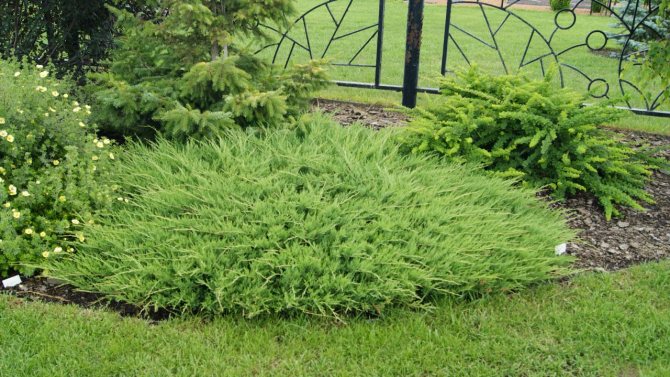

Juniper Cossack is a bush or small trees, reaching a height of 1-1.5 meters. It is able to grow uncontrollably, rooting side branches, forms thickets. Much less often you can find it in the form of a small tree with a curved trunk. Young needles 4-5 mm, needle-shaped. Older needles flatten, tightly fitting to each other like scales. When ripe, cones form small seeds up to 4 pcs. in one fruit. The male and female flowers are found on different plants.
Juniper pruning in autumn
The first pruning can be done only 2-3 years after planting in open ground. This period will allow the young plant to grow stronger and gain weight. After this time, it will be possible to begin to form the crown according to the intended image.
Video: pruning Cossack juniper in autumn or spring
When to prune junipers - fall or spring
Junipers can be pruned during the spring months as well as before the first winter drops in temperature. In autumn, it is recommended to remove excess juniper shoots not earlier than September-October. But you should not delay until the first frost.
Important! The minimum temperature for pruning juniper in the fall is +4 C.
Lower air degrees adversely affect the healing of fresh cuts - they do not heal and are a smart option for wintering pests and diseases.
Timing of pruning juniper in autumn and spring
Spring pruning occurs in early to mid April, and autumn juniper pruning in September until late October.
How to prune junipers in the fall
The event is only required clean, sharpened and disinfected instruments.
First of all, all dried branches or branches affected by parasites or pathogenic bacteria are cut off. In addition, young shoots that grow inward and thicken the crown are subject to removal.
The bush adds no more than 10 cm per year. Therefore, it is required to cut off no more than 15-20% of the mass that has grown over the past period.
You need to prune only with protective gloves... Juniper poisonous, secretes juice on the cut, which can burn the skin of the hands.
Pruning should be done according to the rules - better less than more. If the pruning has led to the thoughtless removal of growth buds, then the shrub can stop its growth completely.
It is recommended to adhere to the following scheme when pruning juniper in the fall:
- You need to trim so that the slope is 45 degrees per kidney.
- If you cut it lower than required, then the wound on the tree will heal for a long time. This will provoke abnormal growth of the kidney - it can give either a small increase or completely die off (dry out).
- If the shoot looks up, then it is cut so that the final bud is that looks away from the center of the plant (outer bud). In the case of a lowered branch, the pruning is done, on the contrary, to the inner bud.
- When removing branches, a small stump should be left - no more than 2 cm. It will block the upper bud from dying tissues, giving it the opportunity to start growing.
Top dressing and fertilization of juniper after autumn pruning
Important! After pruning the juniper in the fall, you need to monitor its condition. It is recommended to apply special mineral fertilizers. Stimulants-adaptogens are best suited for raising immunity. They stimulate the growth of the root system and strengthen the tree as a whole.
Choosing a place for planting juniper
Juniper grows well only in open, sunny places. Sunlight should be available throughout the day.Some shading is allowed only when growing common juniper, but also to a small extent. The decorativeness of plants, the density of branches and needles depends on the intensity of illumination. In a juniper growing in the shade, the branches will grow little, they will be randomly, forming a shapeless loose mass. The variegated needles will lose their original color scheme.


How to choose the right seedlings
The quality of the seedling itself has a significant impact on how successfully a bush will take root. When buying material for planting, the following nuances should be considered:
- Refrain from buying a seedling with open roots.
- It is better to give preference to a plant in a container or with a clod of earth wrapped in non-woven material.
- The current growth of branches and roots should be viewed.
- It is also important that there are no cracks or any other damage to the barrel.
- The new growth must be flexible and not break.
- The color of the leaves must be uniform, without spots.
- It is advisable to purchase seedlings that were originally grown in pots.
Diseases and pests
Junipers, like many conifers, are susceptible to diseases caused by various groups of fungi, for example, rust. It manifests itself in the form of orange growths on the branches and trunk of the tree. The complex development cycle of this group of fungi requires two hosts, in addition to the juniper, they need a tree from the Rosaceae family. Apple, mountain ash, pear or hawthorn will do, depending on the variety. Treatment is a complex process that requires the removal of the affected branches with a sterile pruner and the treatment of the entire plant with fungicides.
Damage to the plant by fungi of the genus Fusarium leads to the drying out of the entire plant, starting from the top. The needles become red, the roots of the plant turn black. The most common cause of infection is waterlogging on heavy clay soils. If dry branches are found, they should be removed, the whole plant and soil should be treated with drugs such as Maxim and Fitosporin. The infection can stay in the ground and the plant for a long time. If possible, it is better to completely remove the soil.
What are junipers combined with?
Ephedra is considered the king of landscape art. It is perfect for slopes, retaining walls and curbs. Perhaps container, group, single cultivation at the front entrance or in the central part of the site. With thorny plantings, landscape designers create hedges and rock gardens. Cases of using a coniferous long-liver to prevent soil erosion are not excluded. When choosing seedlings, it is important to remember that the juniper does not tolerate gas pollution, therefore, its use is excluded for the landscape of a metropolis.
When placing a new recruit, gardeners should take into account that not all plants can withstand a company with a juniper. For example, capricious roses, graceful peonies and clematis are planted no closer than 2 m. The remaining distance is filled with orange or yellow spireas, barberry or dwarf heathers. For the purpose of framing the remaining gaps, thyme, tenaciousness, and saxifrage are chosen. For charisma, boulders and granite chips are used.
The stone allows you to create natural transitions between plantings.
The winning blow is a combination of Green Aul or Saybrook Gold with stonecrops and red-leaved viburnum. Larch, yew, pine, fir, evergreen boxwood are recognized as successful companions. Juniper serves as a wonderful backdrop for daylilies, lavender. Specimens with bluish or golden needles stand out favorably against the background of mosses, lichens, heather.
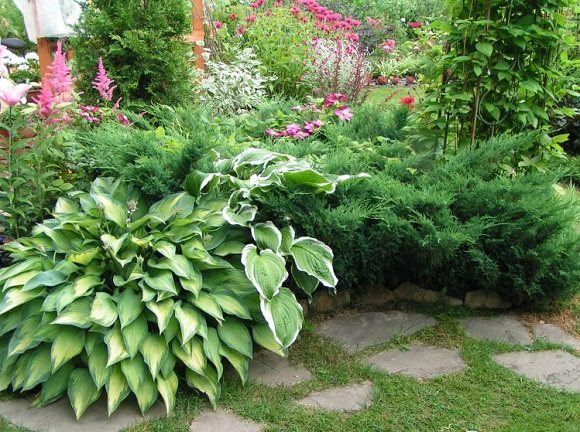

Neighborhood ephedra with hosts
Growing juniper: photo
Florist tips
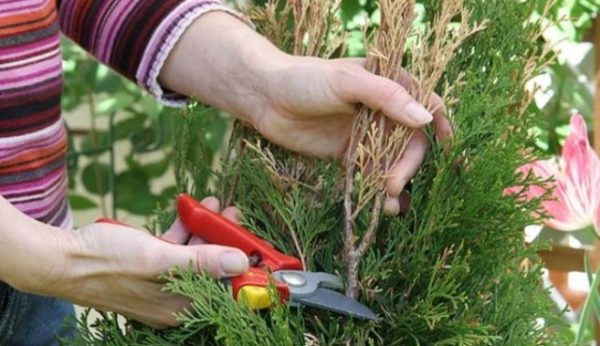

Damaged branches are cut off to the level of a healthy area by sultry heat or long frosts. Clay is added to soil containing a lot of sand, or very dry. If you sprinkle the needles with plain water, they will retain their elasticity and freshness longer.
Planting an evergreen coniferous plant in your area is a very wise decision.Indeed, in addition to a pleasant smell, it is beneficial - it has a bactericidal property (kills bacteria). The branches are cut and placed in the room where the patient with bronchial asthma, or ARVI, lives. From the variety of varieties of juniper bush, it is easy to choose the one that suits the specific idea or idea of its owner.
Site selection and preparation
Juniper in the country prefers sunny places, but it can grow in shaded areas.
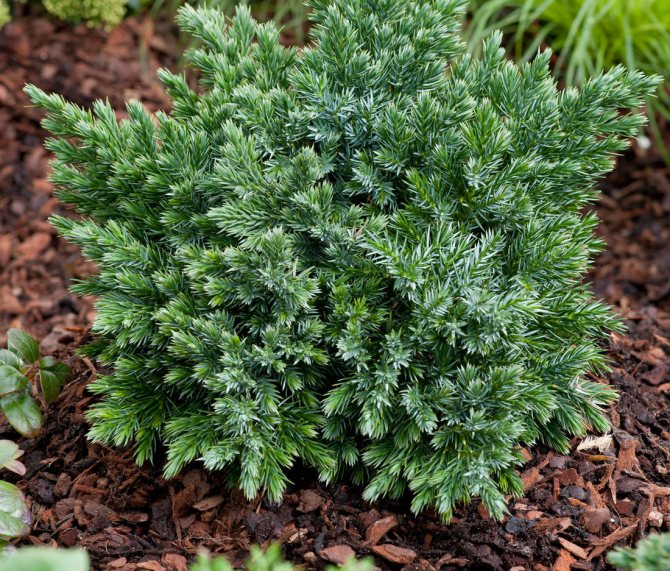

It should be borne in mind that some varieties grow rapidly.
There is a danger that after a few years, instead of neat bushes, coniferous thickets are formed, and planting is detrimental to the culture.
It is necessary to accurately align the distance between the planting holes.
The hole itself should be wider and deeper than the size of the earthen clod on the roots of the seedling. The depth of the planting pit is 70 cm.
The soil for juniper should not be too rich. The saturated composition will provoke cracking of the bark and a decrease in winter hardiness.
Major mistakes
- Making attempts to preserve the shoots burned by the sun rays when all the buds die. If there is not a single bud left on the branch, then it can no longer be saved, and it must be cut off in time so as not to take away extra strength and nutrients from the bush.
- Buying and growing shrubs with an open root system in the absence of proper experience. Many novice growers do not know at all that a juniper can have a different type of root system, while growing an open variety is quite difficult and without providing the necessary care it can die.
- Damage to the root system when transplanting a bush in adulthood. The juniper does not tolerate any wounds that are inflicted on its roots very badly, and this can lead to its death. For this reason, the shrub must first be dug up with a garden pitchfork and pulled out only together with a part of the soil.
Juniper plant neighbors
Not all plants tolerate close proximity to conifers, for example, this applies to clematis, peonies, roses and other large flowering representatives of the flora. Small ground cover plants, on the other hand, thrive on thorny cousins and help set off their beauty.
Quite good neighbors for the "northern cypress" are spirea and boxwood, as well as various types of saxifrage. Heather and garden hydrangea live remarkably next to the conifers, you can learn more about it here. Cotoneaster and barberry provide a backdrop for the larger conifers, and some cereals complement the picture. Also, do not forget about small flowers.
Naturally, juniper looks good with other conifers in landscape design - with mountain pine or small spruces, for example.
Beneficial features
Juniper:
- perfectly cleans and disinfects the air;
- removes headaches;
- has a calming effect on the nervous system;
- normalizes sleep.
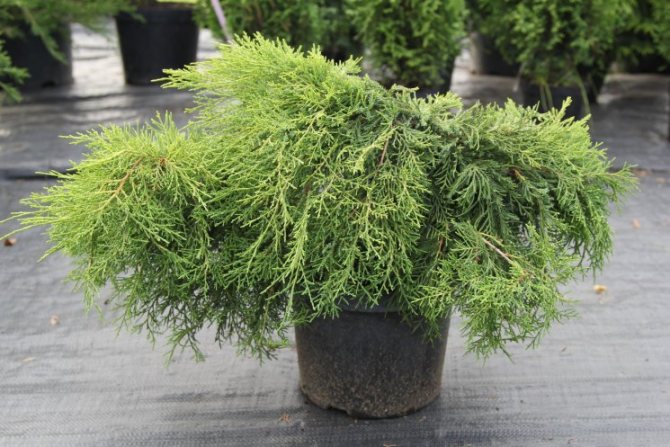

Our ancestors also used this medicinal ephedra as a remedy for various ailments.
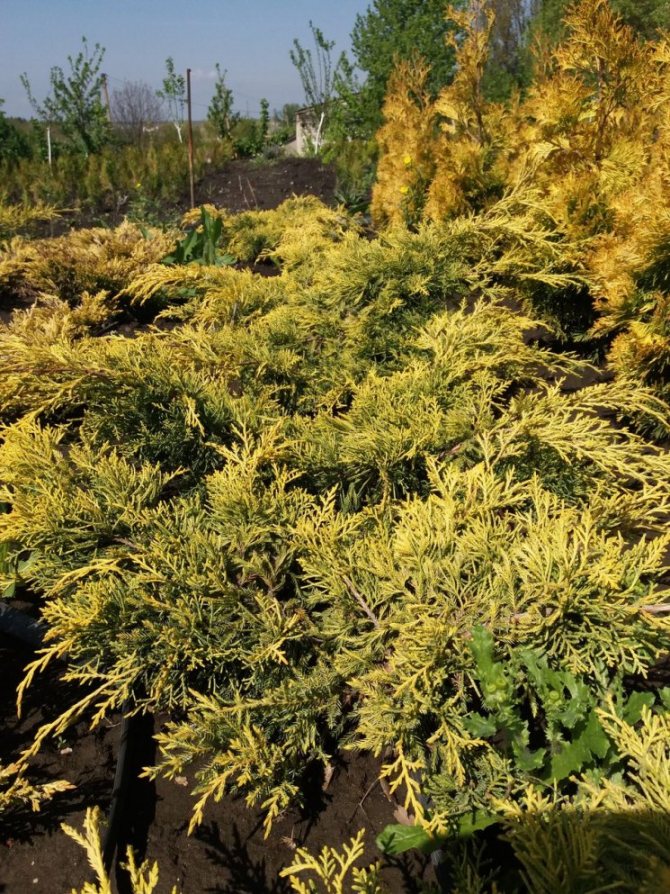

In ancient Egypt, it was used to fumigate rooms during epidemics, and floors were rubbed with pine needles. The North American Indians discovered the property of juniper to cure diseases of the skin and joints.


Juniper berries are rich in sugars and organic acids. They contain essential oils, resins, wax, dyes, trace elements and vitamins.
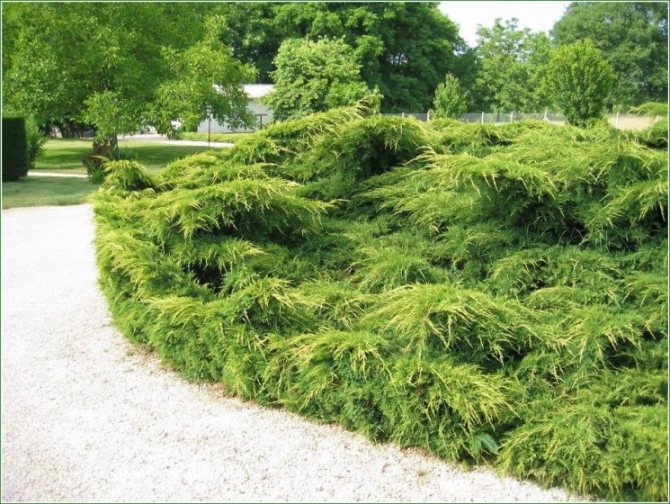

The needles are a storehouse of ascorbic acid, and the bark is a storehouse of tannins.
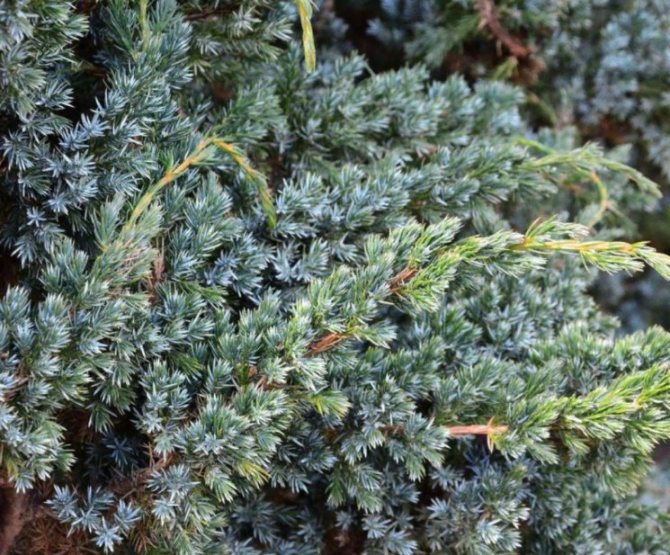

Once again about landscape design
Of course, the possibility of using juniper to decorate the site depends on the general stylistic solution. This plant is perfect for gardens with the correct geometry, decorated in the English or Scandinavian style, Japanese gardens or stone compositions are also difficult to imagine without this ephedra.
Juniper Virginia "Skyrocket" Juniper ordinary "Compressa"
Depending on the idea, the "northern cypress" can serve as both a central plant and a background for others. Based on this, the shapes and colors of this wonderful shrub are selected.
Location on the flowerbed: 8 beautiful patterns
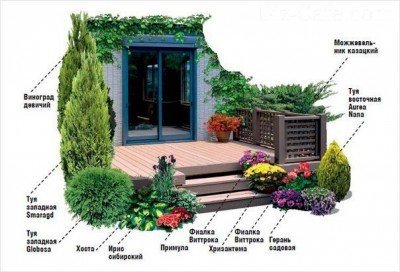

Juniper Cossack is one of the most frost-resistant varieties, ideal for planting in central Russia
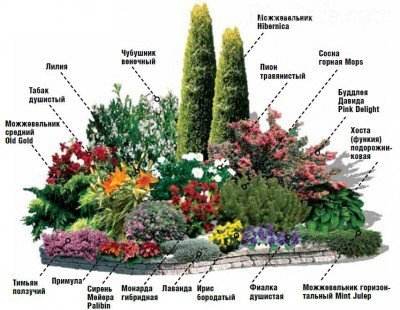

Hiberic's columnar juniper acts as a focal point in the flower bed
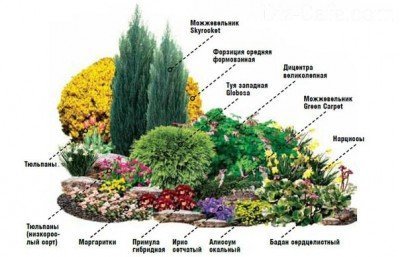

Several types of juniper can be combined on a flower bed: rocky, horizontal, Chinese - any combination will be successful


1. Thuja western "Holmstrup". 2. Barberry Thunberg "Red Chief". 3. Mountain pine "Mops". 4. Juniper medium "Old Gold". 5. Juniper Cossack "Tamariscifolia". 6. Ground cover perennials (bryozoan, stonecrop)
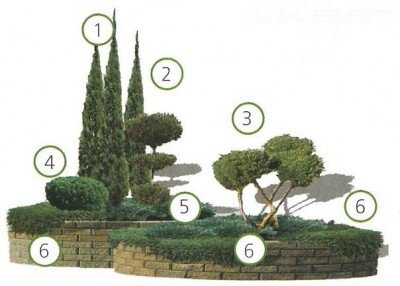

1. Rocky juniper "Blue Arrow". 2. Juniper rocky molded "Skyrocket". 3. Juniper scaly molded "Meyeri". 4. Mountain pine "Mops". 5. Juniper horizontal "Blue Chip". 6. Juniper leaning "Nana"
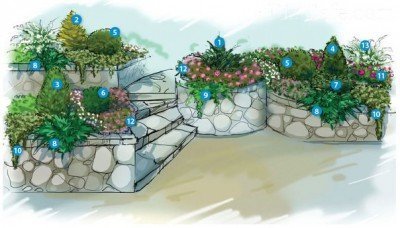

1. Chinese juniper "Blaauw" or "Blue Alps". 2. Thuja western "Stolwijk" or "Rheingold". 3. Thuja eastern "Aurea Nana". 4. Canadian spruce "Conica". 5. Thuja western "Tiny Tim" or "Little Champion". 6. Mountain pine "Gnom". 7. Colorado spruce "Glauca Globosa" or European "Nidiformis". 8. Juniper horizontal "Blue Chip" or "Prince of Wales". 9. Juniper horizontal "Wiltonii". 10. Dammer's cotoneaster. 11. Ground cover roses. 12. Flowers: petunia, subulate phlox, aubrieta, thyme, verbena. 13. Spirea "Snowmound"


Juniper with an original crown plays the role of an accent on an alpine slide


1. Molded Cossack juniper. 2. Siebold's sedum. 3. Sedum is caustic. 4. Iris dwarf. 5. Garden iris (bearded, medium-sized). 6. Ear primrose. 7. Iberis is evergreen. 8. Sod meadow. 9. The hybrid was rejuvenated. 10. Soddy saxifrage. 11. Muscari tufted. 12. Small-leaved bell
Features of the
Juniper belongs to the Cypress family. Its other name is veres or juniper. Today, it is known about the existence of about seven dozen species of this plant, belonging to the genus of evergreen trees or shrubs.
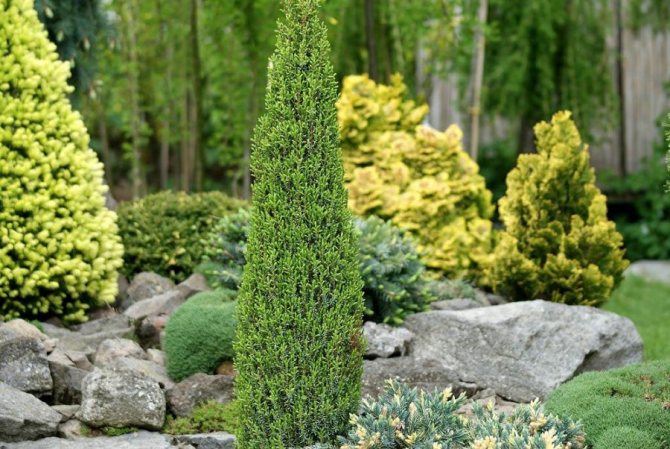

The creeping species grows in the highlands of Nepal, India, Pakistan, and the tree-like form can be seen in the Mediterranean, North America and central Asia. The lifespan of a juniper is from 600 to 3000 years. Its height can reach 15 meters. Below is a description of the juniper.
The most common shrub form is in the form of a bush with a height of 1-3 meters with an erect, branched trunk. The color of the bark depends on age - in young plants it has a terracotta shade, in old plants it is brown. The leaves are needle-shaped or scaly-shaped, collected in whorls.


The main feature is hard and sharp needles, the length of which can reach 1 cm. Juniper begins to bear fruit in 2-3 years. Fruits are green at first, and, when ripe, become bluish-black. Their size ranges from 5 to 10 mm in diameter.


The flowering time is May, and the ripening time for cones is September, October. Juniper berries are considered medicinal and are widely used in medicine.
Pruning, shaping and propagation
Pruning Cossack juniper should be done carefully and deliberately. As a rule, he does not need such manipulations, but with the help of garden shears for cutting bushes, it is necessary to remove damaged, infected and dry branches in a timely manner. Pruning is used when they want to change the direction of growth of branches, stop growth or give a special decorative shape.
The formation of the Cossack juniper is carried out in spring and autumn, while the average daily air temperature should be + 4 ° С. During the year, the Cossack juniper can grow up to 10 cm, and the permissible pruning rate in this case should not exceed 2 cm. The plant, as a rule, does not need to cover up the wounds. If severe damage is present, then the cut can be treated with resin or sprayed with Epin.
Plucking out the tips of new shoots is a safer and less harmful way of forming a crown than cutting. This way you can strengthen the branching and make the bush more lush.
There are 4 ways to breed Cossack juniper:
- By seeds - this is a rather complicated method, which is rarely resorted to due to forced stratification.The seeds of the plant are kept for a long time in special conditions to stimulate germination.
- Cutting - This method is best used in April or August. The weather should be cloudy for several days so that the bright sun does not harm the cuttings and the original plant.
- Layers - this method is great for creeping plant forms with young shoots. Individual branches are fixed on the ground with wooden pins, and the soil around is piled up and watered from time to time.
- Vaccinations - this method does not always justify itself. An elite variety of a plant is grafted onto an ordinary one, wrapped with foil and await engraftment.
How to propagate a Cossack juniper is a personal decision of a specialist or an amateur gardener. However, it is important to do everything so as not to damage the original plant.






